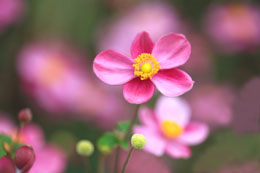Introduce yourself to the beauty that abounds. Japanese anemone plant is a subliminal sight to behold. Learn all about this breathtaking bloom through this article.

Japanese anemone is reckoned the crowning glory of the garden. It bears flowers that personify aestheticism. This plant has a celestial aura that plumps up the garden foliage with variegated colors. The little flowers adorned by the plant look like stars that emit the light of extravagant beauty.
Facts
- The term Anemone is derived from the Greek word anemos, which means wind. Hence, this plant is also known as windflower.
- With respect to plant taxonomy, it is called Anemone X Hybrida.
- The Anemone clan has its aboriginal roots in China, which gradually spread to North America and Japan.
- Some of the most popular and well-known flowering plants out of the 120 species are Snowdrop windflower, Narcissus Anemone, Buttercup anemone, and Pasque flower.
- The species mentioned above are in close relation to the Japanese Anemone. There have been occasions where these names have been interchangeably used to denote the Japanese Anemone.
- The perennials predominantly bear pink, white, and blue flowers.
- This plant is an easy-to-grow perennial.
- Partially-shaded areas are best suited for the growth of these plants. This will aid them to garner the morning dew and sunshine that is rich in essential nutrients. If they are exposed to heavy sunlight, they may have a faded color. If kept in full shade, they will bear fewer flowers, but these will be deeper in color.
- These plants can thrive in acidic as well as alkaline soil. Adding organic fertilizers to the soil will make them healthier.
- Spring or early autumn is the best time to grow these plants.
- These plants also possess some medicinal properties that help in reducing cramps, regulating menstrual cycles, and managing depression.
Growing- Choose plants that look healthy and have buds.
- Plant them in partial light for an optimized growth and color pattern.
- Before planting these, ensure that the soil drainage is good.
- The next step is to add organic seaweed fertilizers to the flower pot.
- Place the plants in the flower pot at a considerable height.
- Position each of them 10 to 20 inches away from one another.
- Water the plant adequately. Excessive watering may lead to adverse effects on the plant.
Caring
- A diligent watering timetable will be very helpful for the development of the plant.
- Mulch around the plant by adding organic compost to the pot during spring.
- Get rid of old and dry foliage before new leaves shoot up. This would give a neat appearance to the plant.
- For a bumper growth, chop the foliage during autumn. The plant will be fit and upright by spring.






 Japanese anemone is reckoned the crowning glory of the garden. It bears flowers that personify aestheticism. This plant has a celestial aura that plumps up the garden foliage with variegated colors. The little flowers adorned by the plant look like stars that emit the light of extravagant beauty.
Japanese anemone is reckoned the crowning glory of the garden. It bears flowers that personify aestheticism. This plant has a celestial aura that plumps up the garden foliage with variegated colors. The little flowers adorned by the plant look like stars that emit the light of extravagant beauty.